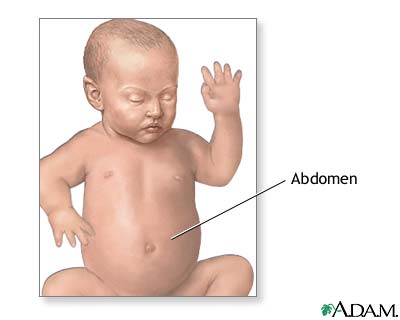Gastroschisis repair
Alternative names
Abdominal wall defect repair
Definition
Gastroschisis repair is surgery that corrects a congenital defect in which all or parts of the small intestine and other internal organs protrude outside of the abdomen. Gastroschisis is an abdominal wall defect located to the side of the umbilical cord (umbilicus). The infant is born with intestines protruding through this defect and no protective sac is present.
Gastroschisis is rarely associated with other birth defects. Gastroschisis and omphalocele (a similar defect) are frequently diagnosed by ultrasound examinations before birth. See also omphalocele repair.

In the womb, fetal intestines develop outside of the abdomen for a brief time. Normally, the intestines return to the abdominal cavity and the abdomen is closed at birth.
Description
Surgical repair of abdominal wall defects involves placing the abdominal organs back into the abdomen through the defect, and repairing the defect if possible. If immediate replacement is not possible, a sterile pouch is created to protect the intestines while they are gradually pushed back into the abdomen over a period of time.
Immediately after delivery, the infant’s exposed organs are covered with warm, moist, sterile dressings. A nasogastric (NG) tube is inserted through the baby’s nose or mouth into the stomach to keep the stomach empty, to prevent choking on or breathing stomach contents into the lungs (aspiration). This surgery is done as soon as the infant is stable.
While the baby is under general anesthesia (unconscious and pain-free) an incision is made to remove the sac membrane. The intestine is examined closely for signs of damage or additional birth defects. Damaged or defective portions are removed and the healthy edges are stitched together.
A tube may be inserted into the stomach (gastrostomy tube) and out through the skin. The organs are replaced into the abdominal cavity and the incision closed, if possible.
If the abdominal cavity is too small or the protruding organs are too swollen to allow the skin to be closed, a pouch called a silo will be made from a sheet of plastic to cover and protect the organs. Complete closure may be done over a few weeks. Surgery may be necessary to repair the abdominal muscles at a later time.
The baby’s abdomen may be smaller than normal. Placing the abdominal organs into the abdomen increases the pressure within the abdominal cavity and can cause breathing difficulties. The infant may require the use of a breathing tube and machine (ventilator) for a few days or weeks until the swelling of the abdominal organs has decreased and the size of the abdomen has increased.
Indications
Gastroschisis is a life-threatening birth defect requiring immediate intervention at birth.
Risks
Breathing difficulties may occur as a result of increased pressure in the abdomen when the gastroschisis is closed. In this case, mechanical ventilation may be necessary.
Other risks of major abdominal surgery include peritonitis and temporary paralysis of the small bowel.
If a large portion of the small bowel is damaged, the infant may develop short bowel syndrome and have problems digesting and absorbing feedings.
Expectations after surgery
The defect can be corrected with surgery in most cases. The outcome depends on the amount of damage to or loss of intestine.
Convalescence
The infant will be cared for postoperatively in a neonatal intensive care unit. The baby is placed in an isolette (incubator) to keep warm and prevent infection. Oxygen is given and mechanical ventilation is often required. Intravenous fluids, antibiotics, and pain medication will be given.
An NG tube will be in place to keep the stomach emptied of gastric secretions. Feedings are started by NG tube as soon as bowel function resumes. Feedings are started very slowly and often infants are reluctant to feed. These babies may need feeding therapy and lots of encouragement.
Diseases and Conditions Center
All ArmMed Media material is provided for information only and is neither advice nor a substitute for proper medical care. Consult a qualified healthcare professional who understands your particular history for individual concerns.